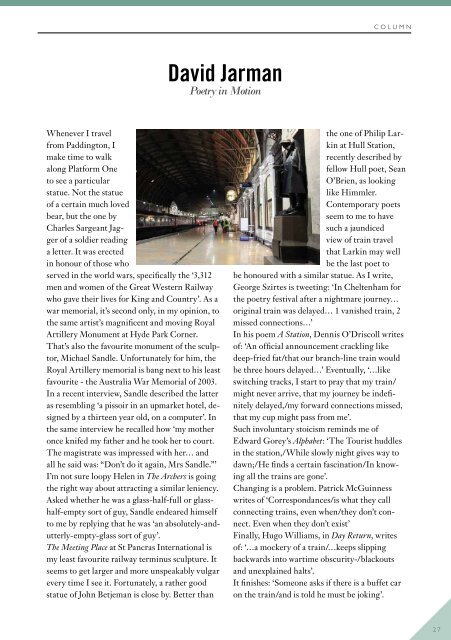You also want an ePaper? Increase the reach of your titles
YUMPU automatically turns print PDFs into web optimized ePapers that Google loves.
COLUMN<br />
David Jarman<br />
Poetry in Motion<br />
Whenever I travel<br />
from Paddington, I<br />
make time to walk<br />
along Platform One<br />
to see a particular<br />
statue. Not the statue<br />
of a certain much loved<br />
bear, but the one by<br />
Charles Sargeant Jagger<br />
of a soldier reading<br />
a letter. It was erected<br />
in honour of those who<br />
served in the world wars, specifically the ‘3,312<br />
men and women of the Great Western Railway<br />
who gave their lives for King and Country’. As a<br />
war memorial, it’s second only, in my opinion, to<br />
the same artist’s magnificent and moving Royal<br />
Artillery Monument at Hyde Park Corner.<br />
That’s also the favourite monument of the sculptor,<br />
Michael Sandle. Unfortunately for him, the<br />
Royal Artillery memorial is bang next to his least<br />
favourite - the Australia War Memorial of 2003.<br />
In a recent interview, Sandle described the latter<br />
as resembling ‘a pissoir in an upmarket hotel, designed<br />
by a thirteen year old, on a computer’. In<br />
the same interview he recalled how ‘my mother<br />
once knifed my father and he took her to court.<br />
The magistrate was impressed with her… and<br />
all he said was: “Don’t do it again, Mrs Sandle.”’<br />
I’m not sure loopy Helen in The Archers is going<br />
the right way about attracting a similar leniency.<br />
Asked whether he was a glass-half-full or glasshalf-empty<br />
sort of guy, Sandle endeared himself<br />
to me by replying that he was ‘an absolutely-andutterly-empty-glass<br />
sort of guy’.<br />
The Meeting Place at St Pancras International is<br />
my least favourite railway terminus sculpture. It<br />
seems to get larger and more unspeakably vulgar<br />
every time I see it. Fortunately, a rather good<br />
statue of John Betjeman is close by. Better than<br />
the one of Philip Larkin<br />
at Hull Station,<br />
recently described by<br />
fellow Hull poet, Sean<br />
O’Brien, as looking<br />
like Himmler.<br />
Contemporary poets<br />
seem to me to have<br />
such a jaundiced<br />
view of train travel<br />
that Larkin may well<br />
be the last poet to<br />
be honoured with a similar statue. As I write,<br />
George Szirtes is tweeting: ‘In Cheltenham for<br />
the poetry festival after a nightmare journey…<br />
original train was delayed… 1 vanished train, 2<br />
missed connections…’<br />
In his poem A Station, Dennis O’Driscoll writes<br />
of: ‘An official announcement crackling like<br />
deep-fried fat/that our branch-line train would<br />
be three hours delayed…’ Eventually, ‘…like<br />
switching tracks, I start to pray that my train/<br />
might never arrive, that my journey be indefinitely<br />
delayed,/my forward connections missed,<br />
that my cup might pass from me’.<br />
Such involuntary stoicism reminds me of<br />
Edward Gorey’s Alphabet: ‘The Tourist huddles<br />
in the station,/While slowly night gives way to<br />
dawn;/He finds a certain fascination/In knowing<br />
all the trains are gone’.<br />
Changing is a problem. Patrick McGuinness<br />
writes of ‘Correspondances/is what they call<br />
connecting trains, even when/they don’t connect.<br />
Even when they don’t exist’<br />
Finally, Hugo Williams, in Day Return, writes<br />
of: ‘…a mockery of a train/…keeps slipping<br />
backwards into wartime obscurity-/blackouts<br />
and unexplained halts’.<br />
It finishes: ‘Someone asks if there is a buffet car<br />
on the train/and is told he must be joking’.<br />
27


















